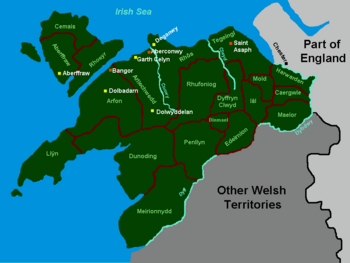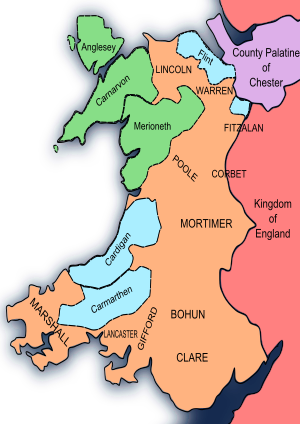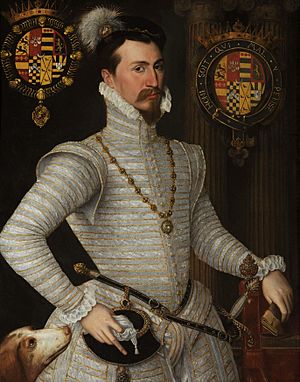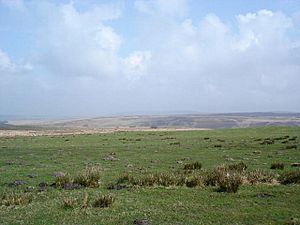Lordship of Denbigh facts for kids
The Lordship of Denbigh was a special area in North Wales that acted like a mini-kingdom. It was created by King Edward I in 1284. This lordship was given to a powerful noble, the Earl of Lincoln. Its main town was Denbigh, where Denbigh Castle was built.
Over the next two centuries, many important English noble families owned the Lordship of Denbigh. There was a long argument in the 1300s between two strong families, the Mortimers and the Montagus, over who truly owned it. Eventually, the lordship returned to the King when Edward, Duke of York, became King Edward IV in 1461. He had inherited it through his family.
Later, in 1563, Queen Elizabeth I brought the lordship back and gave it to her favorite, Lord Robert Dudley. He later became the Earl of Leicester. Leicester borrowed money using the lordship as a guarantee. When he couldn't pay it back, the Queen paid the debt herself, and the lordship became part of the crown's lands again in 1592 or 1593.
Over many years, the crown sold off much of the land that belonged to the lordship. Even though the Lordship of Denbigh still technically exists today, with the Queen as its holder, most of its remaining lands are managed by the Crown Estate. These lands are mainly common land, like the Denbigh moors. The Crown Estate also holds a special yearly court called the Lordship of Denbigh Estray Court. This court still helps find lost sheep in the area and return them to their owners.
Contents
How the Lordship Started

Before the Lordship of Denbigh was created in 1284, this area was part of the Principality of Gwynedd. For a long time, Wales was split into two parts. There were areas ruled by native Welsh princes in the north and center. Then there were "Marcher lordships" in the south and southeast. These were controlled by Anglo-Norman lords who had come to Wales after the Norman invasion in the 11th century.
Marcher lords had a lot of power in their own lands. They were almost independent, only showing loyalty to the King of England. In the 1200s, the Welsh princes of Gwynedd became very strong. They even took the title of Prince of Wales. This made the English King, Edward I, worried. So, he started a war to conquer north Wales between 1277 and 1283.
After the last Prince of Wales, Llywelyn ap Gruffudd, was defeated in 1282, King Edward I divided the conquered lands. He kept most of the land for himself. In 1301, he gave it to his son, who would later become King Edward II. This land became a new Principality of Wales. The rest of the land was given to nobles who had helped Edward I win the war.
In 1284, Edward gave the areas known as cantreds of Rhos and Rhufuniog, and the commote of Dinmael, to Henry de Lacy, 3rd Earl of Lincoln. This became the Lordship of Denbigh. The Earl of Lincoln was one of King Edward I's closest advisors. He had played a big part in the wars in Wales in 1277 and 1282.
History of the Lordship
What a Marcher Lordship Was

The Lordship of Denbigh was a "marcher lordship." This meant it was not officially part of the Kingdom of England. It was like its own independent territory, but it still owed loyalty to the King of England. Like other marcher lordships created by Edward I in North Wales, it was actually held under the Principality of Wales, not directly from the King.
The lordship was managed by a steward. This steward ran a special court called the Curia Baronis. This court, along with two other courts, had a lot of power. It could deal with almost all criminal and civil cases in the area. For managing the land, the lordship was divided into five smaller areas called commotes.
After receiving the lordship, the Earl of Lincoln started building the town of Denbigh. He also built Denbigh Castle to be the center of his new territory. He also began a plan to move native Welsh people out of important areas. Their land was then given to English settlers. Several English communities were formed within the lordship. By 1334, English settlers occupied about 10,000 acres of land.
Changes in Ownership
The Earl of Lincoln died in 1311. His only child, Alice, inherited the lordship. It then passed to Alice's husband, Thomas, Earl of Lancaster. However, Thomas was executed in 1322 for leading a rebellion against King Edward II. So, the lordship returned to the crown.
Next, it was given to King Edward II's favorite, Hugh Despenser. But Despenser lost power in 1326. The lordship was then given to the powerful Earl of March, Roger Mortimer. He, too, lost it for treason in 1330. In 1331, King Edward III gave it to William Montagu, 1st Earl of Salisbury. This was a reward for helping to overthrow Mortimer.
To truly own the lordship, Montagu had to pay a lot of money to Lancaster's widow and the Despenser family. In 1354, Mortimer's grandson won a court case against Montagu's son. The court decided the lordship should go back to the Mortimer family. The reason was that the Montagus didn't have a legal right to it after the earlier charges against Mortimer's grandfather were dropped. The Montagus didn't accept this decision. They kept fighting for the lordship until at least 1397, but they didn't win. This fight between the Montagus and the Mortimers over Denbigh became one of the most famous land disputes among nobles in the 1300s.
From the Mortimer Earls of March, the lordship passed to Richard, Duke of York, in 1425. Richard was a claimant to the throne during the Wars of the Roses. He inherited it from his mother, Anne Mortimer, when the last Mortimer Earl of March died. When Richard died in 1460, his son, Edward of York, inherited the lordship and his father's claim to the throne. When Edward became king in 1461, as Edward IV, the Lordship of Denbigh became part of the crown's possessions.
Becoming Part of the Crown and Later Revival
Even though the lordship became part of the crown in 1461, it kept its own identity. It was still seen as a separate lordship outside the Kingdom of England. This changed when Wales was officially joined with England by the Laws in Wales Acts 1535–1542. These laws ended the special power of the Marcher Lords. They effectively removed their independent courts. However, the old baronial courts were allowed to keep some important rights. They could still handle arguments about land ownership between the tenants and the lordship. This, and its unique identity, kept the lordship important even after 1542.
In 1563, Queen Elizabeth I gave the lordship to her favorite, Lord Robert Dudley. He later became the Earl of Leicester. The Queen's grant said that Denbigh was given to him,
in as large and ample a manner...as was used when it was a lordship marcher with as large wardes as council [sic] learned could devise.
This meant she wanted him to have as much power as the original Marcher Lords. Even though the laws hadn't changed, Leicester was so powerful that he could make this happen in real life.
Leicester's rule over the lordship caused a lot of anger among the local people. After stopping a "rebellion" by the townspeople of Denbigh, Leicester tried to make peace. He built the first Town Hall and a Market Hall. He also started building a chapel.
In 1585, Leicester borrowed £15,000 by using the lordship as a guarantee to a group of London merchants. When he died, the debt was still unpaid. So, the Queen paid off the debt herself, and the Lordship returned to the crown in 1592 or 1593.
In 1696, King William III briefly gave the Lordship of Denbigh to the Earl of Portland. But the people of Denbigh strongly objected. They asked Parliament to stop the grant, and it was canceled.
Over time, the crown sold off much of the original land of the lordship. This happened especially during the reign of King Charles I and during the Commonwealth period.
What's Left of the Lordship Today?
The Lordship of Denbigh still exists today. The Queen is its "Lord of the Manor." Like all land owned by the crown, the remaining lands of the lordship are managed by the Crown Estate. In Denbighshire, the Crown Estate now only manages common land and the coastline. This includes parts of the Denbigh Moors, which are known in Welsh as Mynydd Hiraethog.
There is also a special Lordship of Denbigh "Estray Court." According to a 2011 report about the Crown Estate in Wales:
Once a year, usually a Saturday in July, an Estray Court meets. It allows commoners to claim their lost sheep. If a claim is successful, a small "fine" is paid to the Court. Then the sheep are returned. Animals that are not claimed, or whose claims are rejected, are sold at an auction at the end of the meeting.
When most local courts were going to be abolished in 1977, the Estray Court was one of the few that were kept. Lord Elwyn-Jones, who was in charge of the law at the time, told Parliament that "the Estray Court for the Lordship of Denbigh ... is a very useful court, and it would be quite wrong to abolish it."
Lords of Denbigh
- Henry de Lacy, 3rd Earl of Lincoln, 1284–1311
- Thomas, 2nd Earl of Lancaster, 1311–1322 (through his wife Alice de Lacy)
- Hugh le Despenser, 1st Earl of Winchester, 1322–1326
- Roger Mortimer, 1st Earl of March, 1327–1330
- William Montagu, 1st Earl of Salisbury, 1331–1344
- William Montagu, 2nd Earl of Salisbury, 1344–1354
- Roger Mortimer, 2nd Earl of March, 1354–1360
- Edmund Mortimer, 3rd Earl of March, 1360–1381
- Roger Mortimer, 4th Earl of March, 1381–1398
- Edmund Mortimer, 5th Earl of March, 1398–1425
- Richard of York, 3rd Duke of York, 1425–1460
- Edward of York, 4th Duke of York, later King Edward IV, 1460–1461
- Merged with the crown after Edward IV became king, 1461–1563
- Robert Dudley, 1st Earl of Leicester, 1563–1588
- Returned to the crown, 1588/1592-1696
- William Bentinck, 1st Earl of Portland, 1696
- Returned to the crown, from 1696




